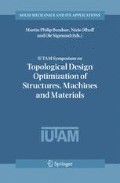Abstract
Natural materials such as bone, tooth, and nacre are nano-composites of proteins and minerals with superior stiffness and toughness. At the most elementary structure level, bio-composites exhibit a generic microstructure consisting of staggered mineral bricks wrapped by soft protein in nanoscale. Why does nature design building blocks of biological materials in this form? Can we reproduce this kind of structure from the structural optimization point of view? We believe that biological materials are designed with simultaneous optimization of stiffness and toughness for maximum structural support and flaw tolerance. With this philosophy, an optimization problem is formulated under the assumption of appropriate material constitutive models and failure criteria. It is shown that, within this optimization framework, the staggered microstructure of biological materials can be successfully reproduced at the nanometer length scale. This study may have at least partially provided an answer to the question whether the nanostructure of biological materials is an optimized structure and what is being optimized. The results suggest that we can draw lessons from the nature in designing nanoscale and hierarchically structured materials.
Access this chapter
Tax calculation will be finalised at checkout
Purchases are for personal use only
Preview
Unable to display preview. Download preview PDF.
References
Aksay, I.A. and Weiner, S. (2004) Biomaterials. Is this really a field of research?, J. Mater. Chem., 14, 2115–2123.
Currey, J.D. (1984) The Mechanical Adaptations of Bone, Princeton University Press, Princeton, NJ, pp. 24–37.
Currey, J.D. (1997) Mechanical properties of mother of pearl in tension, Proc. R. Soc. London, Ser. B, 196, 443–463.
Fratzl, P., Burgert, I. and Gupta, H.S. (2004) On the role of interface polymers for the mechanics of nature polymeric composites, Phys. Chem. Chem. Phys., 6, 5575–5579.
Gao, H., Ji, B., Jager, I.L., Artz, E. and Fratzl, P. (2003) Materials become insensitive to flaws at nanoscale: lessons from nature, Proc. Natl. Acad. Sci. USA, 100, 5597–5600.
Jackson, A.P., Vincent, J.F.V. Turner, R.M. (1988) The mechanical design of nacre, Proc. R. Soc. London, Ser. B, 234, 415–440.
Jager, I.L. and Fratzl, P. (2000) Mineralized collagen fibrils: A mechanical model with a staggered arrangement of mineral particles, Biophys. J., 79, 1737–1746.
Ji, B. and Gao, H. (2004) Mechanical properties of nanostructure of biological materials, J. Mech. Phys. Solids, 52, 1963–1990.
Landis, W.J. (1995) The strength of a calcified tissue depends in part on the molecular structure and organization of its constituent mineral crystals in their organic matrix, Bone, 16, 533–544.
LeeLavanichkul, S. and Cherkaev, A. (2004) Why the grain in tree trunk spirals: A mechanical perspective, Struct. Multidisc. Optimiz., 28, 127–135.
Mening, R., Meyers, M.H., Meyers, M.A. and Vecchio, K.S. (2000) Quasi-static and dynamic mechanical response of Haliotis rufescens (abalone) shell, Mater. Sci. Eng., A297, 203–211.
Smith, B.L., Schaeffer, T.E., Viani, M., Thompson, J.B., Frederick, N.A., Kindt, J., Belcher, A., Stucky, G.D., Morse, D.E. and Hansma, P.K. (1999) Molecular mechanistic origin of the toughness of natural adhesive, fibers and composites, Nature, 399, 761–763.
Tesch, W., Eidelman, N., Roschger P., Goldenberg, F., Klaushofer, K. and Fratzl, P. (2001) Graded microstructure and mechanical properties of human crown dentin, Calcif. Tissue Int., 69, 147–157.
Weiner, S. and Wanger, H.D. (1998) The material bone: Structure-mechanical function relations, Annu. Rev. Mater. Sci., 28, 271–298.
Weiner, S., Veis A., Beniash, E., Arad, T., Dilon, J.W., Sabsay, B. and Siddiqui, F. (1999) Pertubular dentin formation: crystal organization and the macromolecular constituent in human teeth, J. Struct. Biol., 126, 27–41.
Author information
Authors and Affiliations
Editor information
Editors and Affiliations
Rights and permissions
Copyright information
© 2006 Springer
About this paper
Cite this paper
Guo, X., Gao, H. (2006). Bio-Inspired Material Design and Optimization. In: Bendsøe, M.P., Olhoff, N., Sigmund, O. (eds) IUTAM Symposium on Topological Design Optimization of Structures, Machines and Materials. Solid Mechanics and Its Applications, vol 137. Springer, Dordrecht . https://doi.org/10.1007/1-4020-4752-5_43
Download citation
DOI: https://doi.org/10.1007/1-4020-4752-5_43
Publisher Name: Springer, Dordrecht
Print ISBN: 978-1-4020-4729-9
Online ISBN: 978-1-4020-4752-7
eBook Packages: EngineeringEngineering (R0)

